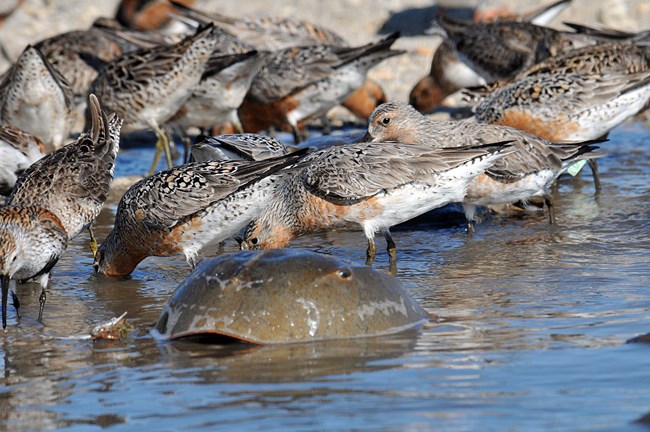
Photo/United States Fish and Wildlife Description The rufa red knot is 10 to 11 inches in length with a 19 to 21-inch wingspan. This stocky, sandpiper had a distinctive rusty-red breast during spring migration. Rufa red knots are a subspecies of red knots (Calidris canutus) that migrate through eastern North America. When it migrates through Massachusetts in late summer and fall on its way to the wintering grounds, it will have a dull gray appearance. They are speckled with black and white on their backs with black eyes, legs, and a black bill. Distribution and Abundance Along the Atlantic Coast Some red knots fly more than 9,000 miles from south to north every spring and repeat the trip in reverse every autumn. This makes red knots one of the longest-distance migrants in the animal kingdom. An estimated 80% of the New World populations of Red Knots and Whimbrels migrate through the North Atlantic region each spring. The non-breeding range of this species covers most of the Atlantic and Carribean coasts of South America, the western Gulf of Mexico, and south along both coasts of Central America, and the southeast United States from North Carolina to Alabama. Smaller numbers of knots winter along the mid-Atlantic and the Northeast United States. Red knots use coastal areas in Massachusetts as migratory stopover locations for foraging during spring and fall migration as they move between their Arctic breeding and wintering grounds. Historically, thousands of red knots were recorded along the Massachusetts shoreline during spring and fall. While their numbers have decreased during spring migration (May-June), large numbers of knots continue to stop-over during fall migration (July-September). Both outer Cape Cod and West Cape Cod Bay beaches serve as major historical migratory stop-over locations for red knots in Massachusetts. Reported numbers of red knots using outer Cape Cod during fall migration has remained steady over the last 50 years, while numbers of knots using the mainland has declined dramatically over this same time period. Breeding and Feeding Habits Red Knots are Arctic breeders with nesting areas in both northern Alaska and Canada. They nest on sparsely vegetated tundra habitat within 30 miles of the coast on ridges or slopes and typically breed between June and August. Ground nests are prepared with grasses and leaves of nearby plants, usually willows and avens, and finished off with lichen or mountain-heather. Red knots are territorial and do not nest close to one another. Both the female and male participate equally in egg incubation of typically 3 to 4 eggs. The incubation period is 21 to 23 days. The young are precocial, meaning they can leave the nest within 24 hours of hatching and can forage for themselves. They learn to fly when they are approximately 18 days old. During wintering and migration periods, red knots feed on a variety of bivalves and crustaceans on sandy beaches and in intertidal areas in Massachusetts. High tide causes the red knots to move up higher on the beach and roost in groups while the intertidal zone is not exposed. Red knots are molluscivores. Eating hard-shelled mollusks is their specialty thanks to their large gizzards which allow them to grind the hard shells of their prey. They will also take advantage of consuming easily accessed softer invertebrate prey, such as crab- and shrimp- like organisms, marine worms, and horseshoe crab eggs. During their time in the Arctic, red knots will feed on seeds and shoots of grasses but quickly switch to invertebrates when they become available. 
Photo/United States Fish and Wildlife Threats Rufa red knot populations have declined by 75% since the 1980s. Their population decline is credited to the reduction of horseshoe crab eggs in Delaware Bay. This is a major stop-over spot for red knots during their spring migration where they historically would feed on an abundance of horseshoe crab eggs to provide them with critical fat reserves they would use on their long flight. Commercial overharvesting of horseshoe crabs for medical research and as bait has led to an insufficient food source for the red knots. When they do not put on the weight they need; the red knots are either unable to make it to their destination or they reach their breeding ground in such poor condition that they are not able to successfully reproduce. Red knots are also threatened by loss of breeding habitat due climate change, which is severely affecting their arctic breeding grounds. In the Caribbean and northern South American, red knots are vulnerable to unregulated hunting. Lastly, pollution of their habitat, including oil spills, can negatively impact this species. Protections The rufa red knot was listed as a federally threatened species under the Endangered Species Act on December 9, 2014. Being listed as threatened means the population would be expected to decline if not protected. The Endangered Species Act provides penalties for harassing, harming, or taking the rufa red knot. Red knots are also protected under the Migratory Bird Treaty Act of 1918, which prohibits the take (including killing, capturing, selling, trading, and transport) of protected migratory bird species without prior authorization by the Department of Interior U.S. Fish and Wildlife Service. In 2021, a proposal was released to designate critical habitat for the rufa red knot including area in Cape Cod National Seashore. The National Seashore helps to protect critical breeding habitat and migration stop-over areas for many species of shorebirds. Things You Can Do to Help Protect the Red Knot and Other Shorebirds
|
Last updated: January 31, 2023
